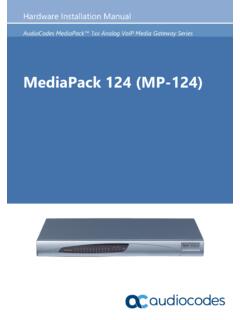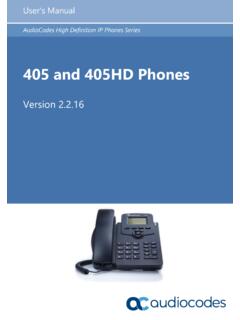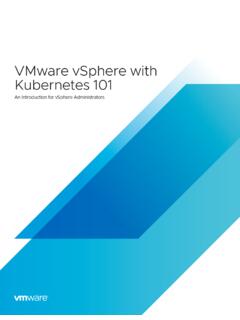Transcription of nnecting Cisco CUCM with Teams Direct Routing Enterprise ...
1 Configuration Note AudioCodes Professional Services Interoperability Lab Connecting Cisco Unified Communications Manager Ver. with Microsoft Teams Direct Routing Enterprise Model using AudioCodes Mediant SBC Version Configuration Note Contents Version 3 AudioCodes Mediant SBC Table of Contents 1 Introduction .. 7 Intended 7 About Microsoft Teams Direct Routing .. 7 About AudioCodes SBC Product Series .. 7 2 Component Information .. 9 AudioCodes SBC 9 Cisco CUCM Version .. 9 Microsoft Teams Direct Routing Version .. 9 Interoperability Test Topology .. 10 Enterprise Model 10 Environment Setup .. 11 Infrastructure Prerequisites .. 11 Known Limitations .. 11 3 configuring Teams Direct Routing .. 13 Prerequisites .. 13 SBC Domain Name in the Teams Enterprise Model.
2 13 Example of the Office 365 Tenant Direct Routing Configuration .. 14 Online PSTN Gateway Configuration .. 14 Online PSTN Usage Configuration .. 14 Online Voice Route Configuration .. 14 Online Voice Routing Policy Configuration .. 14 Enable Online User .. 15 Assigning Online User to the Voice 15 4 configuring Cisco CUCM .. 17 Log in to Cisco Unified Communications 17 Create a New Trunk .. 17 Create a New Route Pattern .. 19 5 configuring AudioCodes SBC .. 23 SBC Configuration Concept in Teams Direct Routing Enterprise Model .. 24 IP Network Interfaces Configuration .. 24 Configure VLANs .. 25 Configure Network Interfaces .. 25 SIP TLS Connection Configuration .. 27 Configure the NTP Server Address .. 27 Create a TLS Context for Teams Direct Routing .
3 28 Configure a Certificate .. 29 Method of Generating and Installing the Wildcard Certificate .. 32 Deploy Baltimore Trusted Root Certificate .. 33 Configure Media Realms .. 34 Configure SIP Signaling Interfaces .. 35 Configure Proxy Sets and Proxy Address .. 36 Configure a Proxy Address .. 37 Configure Coders .. 39 Configure IP Profiles .. 41 Configure IP Groups .. 44 AudioCodes Mediant SBC 4 Document #: LTRT-29313 Microsoft Teams Direct Routing & Cisco CUCM Configure SRTP .. 46 configuring Message Condition Rules .. 47 configuring Classification Rules .. 48 Configure IP-to-IP Call Routing 49 configuring Firewall Settings .. 50 Configure Number Manipulation Rules .. 51 Configure Message Manipulation Rules .. 52 Miscellaneous Configuration .. 59 Configure Call Forking Mode.
4 59 Optimizing CPU Cores Usage for a Specific Service (relevant for Mediant 9000 and Software SBC only) .. 60 A AudioCodes INI File .. 61 Configuration Note Notices Version 5 AudioCodes Mediant SBC Notice Notice Information contained in this document is believed to be accurate and reliable at the time of printing. However, due to ongoing product improvements and revisions, AudioCodes cannot guarantee accuracy of printed material after the Date Published nor can it accept responsibility for errors or omissions. Updates to this document can be downloaded from This document is subject to change without notice. Date Published: November-23-2021 WEEE EU Directive Pursuant to the WEEE EU Directive, electronic and electrical waste must not be disposed of with unsorted waste.
5 Please contact your local recycling authority for disposal of this product. Customer Support Customer technical support and services are provided by AudioCodes or by an authorized AudioCodes Service Partner. For more information on how to buy technical support for AudioCodes products and for contact information, please visit our website at Stay in the Loop with AudioCodes Abbreviations and Terminology Each abbreviation, unless widely used, is spelled out in full when first used. Document Revision Record LTRT Description 29312 Initial document release for Version 29313 Coder Group for Teams was updated. Documentation Feedback AudioCodes continually strives to produce high quality documentation. If you have any comments (suggestions or errors) regarding this document, please fill out the Documentation Feedback form on our Web site at AudioCodes Mediant SBC 6 Document #: LTRT-29313 Microsoft Teams Direct Routing & Cisco CUCM This page is intentionally left blank.
6 Configuration Note 1. Introduction Version 7 AudioCodes Mediant SBC 1 Introduction This Configuration Note describes how to set up the AudioCodes Enterprise Session Border Controller (hereafter, referred to as SBC) for interworking between Cisco CUCM and Microsoft's Teams Direct Routing environment. You can also use AudioCodes' SBC Wizard tool to automatically configure the SBC based on this interoperability setup. However, it is recommended to read through this document to better understand the various configuration options. For more information on AudioCodes' SBC Wizard including the download option, visit AudioCodes Web site at Intended Audience This document is intended for engineers, or AudioCodes and Cisco CUCM partners who are responsible for installing and configuring Cisco CUCM and Microsoft's Teams Direct Routing Service in Enterprise Model for enabling VoIP calls using AudioCodes SBC.
7 About Microsoft Teams Direct Routing Microsoft Teams Direct Routing allows connecting a customer-provided SBC to the Microsoft Phone System. The customer-provided SBC can be connected to almost any telephony trunk, or connect with third-party PSTN equipment. The connection allows: Using virtually any PSTN trunk with Microsoft Phone System configuring interoperability between customer-owned telephony equipment, such as third-party PBXs, analog devices, and Microsoft Phone System About AudioCodes SBC Product Series AudioCodes' family of SBC devices enables reliable connectivity and security between the Enterprise 's and the service provider's VoIP networks. The SBC provides perimeter defense as a way of protecting Enterprises from malicious VoIP attacks; mediation for allowing the connection of any PBX and/or IP-PBX to any service provider; and Service Assurance for service quality and manageability.
8 Designed as a cost-effective appliance, the SBC is based on field-proven VoIP and network services with a native host processor, allowing the creation of purpose-built multiservice appliances, providing smooth connectivity to cloud services, with integrated quality of service, SLA monitoring, security and manageability. The native implementation of SBC provides a host of additional capabilities that are not possible with standalone SBC appliances such as VoIP mediation, PSTN access survivability, and third-party value-added services applications. This enables Enterprises to utilize the advantages of converged networks and eliminate the need for standalone appliances. AudioCodes SBC is available as an integrated solution running on top of its field-proven Mediant Media Gateway and Multi-Service Business Router platforms, or as a software-only solution for deployment with third-party hardware.
9 The SBC can be offered as a Virtualized SBC, supporting the following platforms: Hyper-V, AWS, AZURE, AWP, KVM and VMWare. AudioCodes Mediant SBC 8 Document #: LTRT-29313 Microsoft Teams Direct Routing & Cisco CUCM This page is intentionally left blank. Configuration Note 2. Component Information Version 9 AudioCodes Mediant SBC 2 Component Information AudioCodes SBC Version Table 2-1: AudioCodes SBC Version SBC Vendor AudioCodes Models Mediant 500 Gateway & E-SBC Mediant 500L Gateway & E-SBC Mediant 800B Gateway & E-SBC Mediant 800C Gateway & E-SBC Mediant 1000B Gateway & E-SBC Mediant 2600 E-SBC Mediant 4000 SBC Mediant 4000B SBC Mediant 9000 SBC Mediant 9030 SBC Mediant 9080 SBC Mediant Software SBC (VE/SE/CE) Software Version or later Protocol SIP/UDP or SIP/TCP (to the Cisco CUCM SIP Trunk) SIP/TLS (to the Teams Direct Routing ) Additional Notes None Cisco CUCM Version Table 2-2.
10 Cisco CUCM Version Vendor/Service Provider Cisco SSW Model/Service CUCM Software Version Protocol SIP Additional Notes None Microsoft Teams Direct Routing Version Table 2-3: Microsoft Teams Direct Routing Version Vendor Microsoft Model Teams Phone System Direct Routing Software Version Protocol SIP Additional Notes None AudioCodes Mediant SBC 10 Document #: LTRT-29313 Microsoft Teams Direct Routing & Cisco CUCM Interoperability Test Topology Microsoft Teams Direct Routing can be implemented in the Enterprise or Hosting Models. Enterprise Model Implementation The interoperability testing between AudioCodes SBC and Cisco CUCM with Teams Direct Routing Enterprise Model was done using the following topology setup: Enterprise deployed with Cisco CUCM as IP-PBX, analog devices and the administrator's management station, located on the LAN Enterprise deployed with Microsoft Teams Phone System Direct Routing Interface located on the WAN for enhanced communication within the Enterprise AudioCodes SBC is implemented to interconnect between the Cisco CUCM in the Enterprise LAN and Microsoft Teams on the WAN Session: Real-time voice session using the IP-based Session Initiation Protocol (SIP).















